Haoteng Tang
Inferred global dense residue transition graphs from primary structure sequences enable protein interaction prediction via directed graph convolutional neural networks
Oct 15, 2025Abstract:Introduction Accurate prediction of protein-protein interactions (PPIs) is crucial for understanding cellular functions and advancing drug development. Existing in-silico methods use direct sequence embeddings from Protein Language Models (PLMs). Others use Graph Neural Networks (GNNs) for 3D protein structures. This study explores less computationally intensive alternatives. We introduce a novel framework for downstream PPI prediction through link prediction. Methods We introduce a two-stage graph representation learning framework, ProtGram-DirectGCN. First, we developed ProtGram. This approach models a protein's primary structure as a hierarchy of globally inferred n-gram graphs. In these graphs, residue transition probabilities define edge weights. Each edge connects a pair of residues in a directed graph. The probabilities are aggregated from a large corpus of sequences. Second, we propose DirectGCN, a custom directed graph convolutional neural network. This model features a unique convolutional layer. It processes information through separate path-specific transformations: incoming, outgoing, and undirected. A shared transformation is also applied. These paths are combined via a learnable gating mechanism. We apply DirectGCN to ProtGram graphs to learn residue-level embeddings. These embeddings are pooled via attention to generate protein-level embeddings for prediction. Results We first established the efficacy of DirectGCN on standard node classification benchmarks. Its performance matches established methods on general datasets. The model excels at complex, directed graphs with dense, heterophilic structures. When applied to PPI prediction, the full ProtGram-DirectGCN framework delivers robust predictive power. This strong performance holds even with limited training data.
DRE: An Effective Dual-Refined Method for Integrating Small and Large Language Models in Open-Domain Dialogue Evaluation
Jun 04, 2025Abstract:Large Language Models (LLMs) excel at many tasks but struggle with ambiguous scenarios where multiple valid responses exist, often yielding unreliable results. Conversely, Small Language Models (SLMs) demonstrate robustness in such scenarios but are susceptible to misleading or adversarial inputs. We observed that LLMs handle negative examples effectively, while SLMs excel with positive examples. To leverage their complementary strengths, we introduce SLIDE (Small and Large Integrated for Dialogue Evaluation), a method integrating SLMs and LLMs via adaptive weighting. Building on SLIDE, we further propose a Dual-Refinement Evaluation (DRE) method to enhance SLM-LLM integration: (1) SLM-generated insights guide the LLM to produce initial evaluations; (2) SLM-derived adjustments refine the LLM's scores for improved accuracy. Experiments demonstrate that DRE outperforms existing methods, showing stronger alignment with human judgment across diverse benchmarks. This work illustrates how combining small and large models can yield more reliable evaluation tools, particularly for open-ended tasks such as dialogue evaluation.
Adapting a Segmentation Foundation Model for Medical Image Classification
May 09, 2025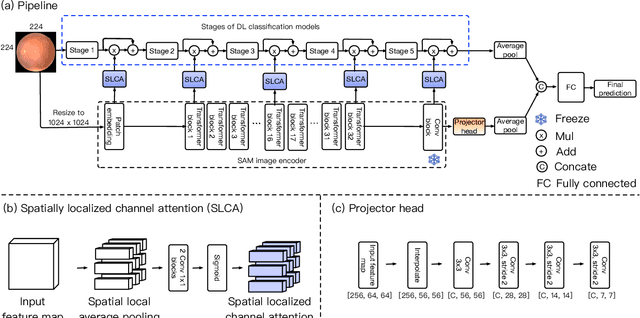
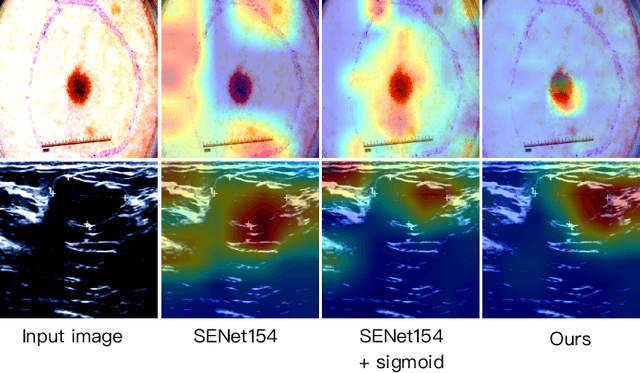
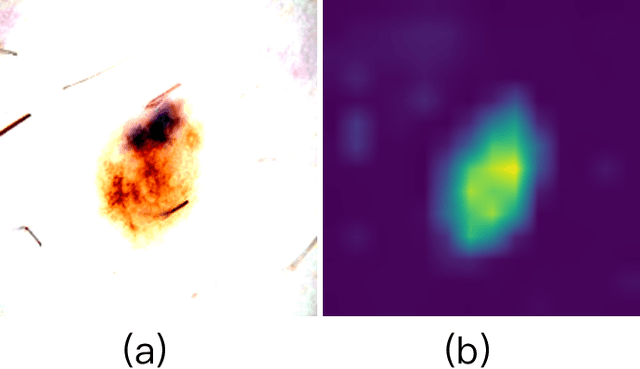
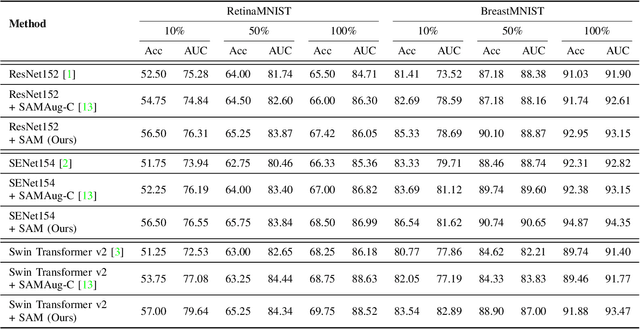
Abstract:Recent advancements in foundation models, such as the Segment Anything Model (SAM), have shown strong performance in various vision tasks, particularly image segmentation, due to their impressive zero-shot segmentation capabilities. However, effectively adapting such models for medical image classification is still a less explored topic. In this paper, we introduce a new framework to adapt SAM for medical image classification. First, we utilize the SAM image encoder as a feature extractor to capture segmentation-based features that convey important spatial and contextual details of the image, while freezing its weights to avoid unnecessary overhead during training. Next, we propose a novel Spatially Localized Channel Attention (SLCA) mechanism to compute spatially localized attention weights for the feature maps. The features extracted from SAM's image encoder are processed through SLCA to compute attention weights, which are then integrated into deep learning classification models to enhance their focus on spatially relevant or meaningful regions of the image, thus improving classification performance. Experimental results on three public medical image classification datasets demonstrate the effectiveness and data-efficiency of our approach.
Topo-VM-UNetV2: Encoding Topology into Vision Mamba UNet for Polyp Segmentation
May 09, 2025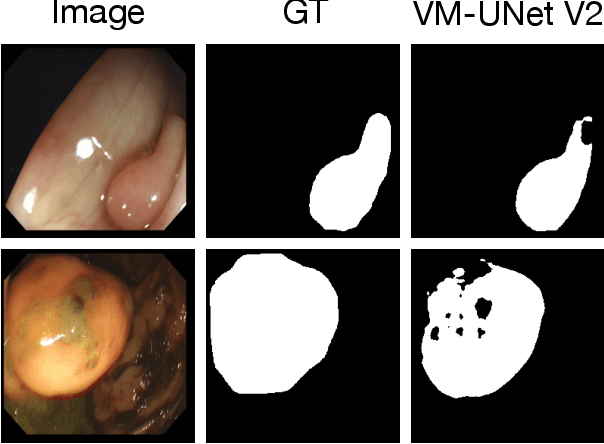


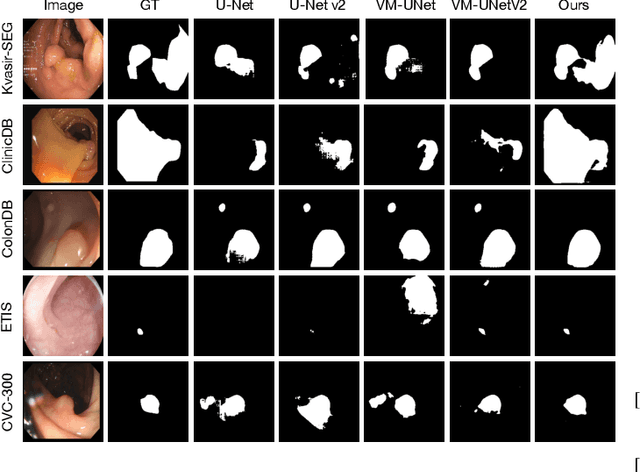
Abstract:Convolutional neural network (CNN) and Transformer-based architectures are two dominant deep learning models for polyp segmentation. However, CNNs have limited capability for modeling long-range dependencies, while Transformers incur quadratic computational complexity. Recently, State Space Models such as Mamba have been recognized as a promising approach for polyp segmentation because they not only model long-range interactions effectively but also maintain linear computational complexity. However, Mamba-based architectures still struggle to capture topological features (e.g., connected components, loops, voids), leading to inaccurate boundary delineation and polyp segmentation. To address these limitations, we propose a new approach called Topo-VM-UNetV2, which encodes topological features into the Mamba-based state-of-the-art polyp segmentation model, VM-UNetV2. Our method consists of two stages: Stage 1: VM-UNetV2 is used to generate probability maps (PMs) for the training and test images, which are then used to compute topology attention maps. Specifically, we first compute persistence diagrams of the PMs, then we generate persistence score maps by assigning persistence values (i.e., the difference between death and birth times) of each topological feature to its birth location, finally we transform persistence scores into attention weights using the sigmoid function. Stage 2: These topology attention maps are integrated into the semantics and detail infusion (SDI) module of VM-UNetV2 to form a topology-guided semantics and detail infusion (Topo-SDI) module for enhancing the segmentation results. Extensive experiments on five public polyp segmentation datasets demonstrate the effectiveness of our proposed method. The code will be made publicly available.
Zeus: Zero-shot LLM Instruction for Union Segmentation in Multimodal Medical Imaging
Apr 09, 2025Abstract:Medical image segmentation has achieved remarkable success through the continuous advancement of UNet-based and Transformer-based foundation backbones. However, clinical diagnosis in the real world often requires integrating domain knowledge, especially textual information. Conducting multimodal learning involves visual and text modalities shown as a solution, but collecting paired vision-language datasets is expensive and time-consuming, posing significant challenges. Inspired by the superior ability in numerous cross-modal tasks for Large Language Models (LLMs), we proposed a novel Vision-LLM union framework to address the issues. Specifically, we introduce frozen LLMs for zero-shot instruction generation based on corresponding medical images, imitating the radiology scanning and report generation process. {To better approximate real-world diagnostic processes}, we generate more precise text instruction from multimodal radiology images (e.g., T1-w or T2-w MRI and CT). Based on the impressive ability of semantic understanding and rich knowledge of LLMs. This process emphasizes extracting special features from different modalities and reunion the information for the ultimate clinical diagnostic. With generated text instruction, our proposed union segmentation framework can handle multimodal segmentation without prior collected vision-language datasets. To evaluate our proposed method, we conduct comprehensive experiments with influential baselines, the statistical results and the visualized case study demonstrate the superiority of our novel method.}
SouLLMate: An Application Enhancing Diverse Mental Health Support with Adaptive LLMs, Prompt Engineering, and RAG Techniques
Oct 17, 2024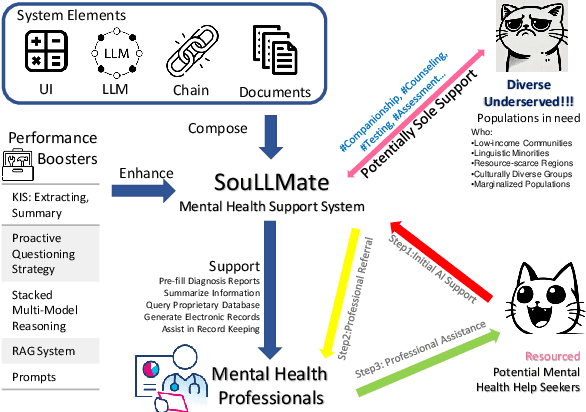
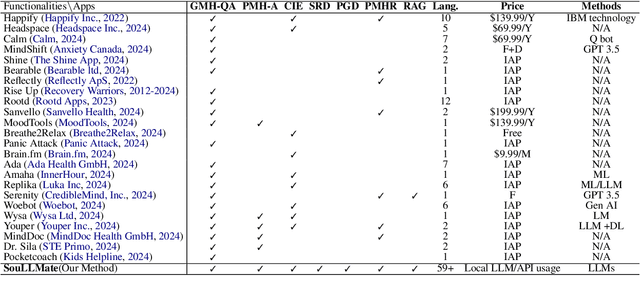
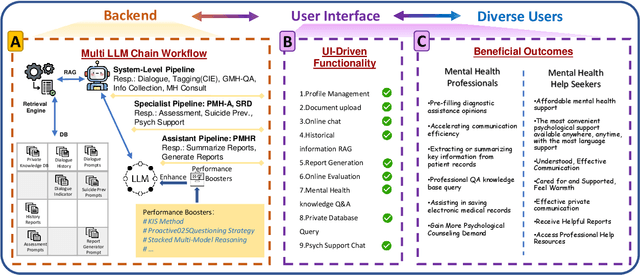
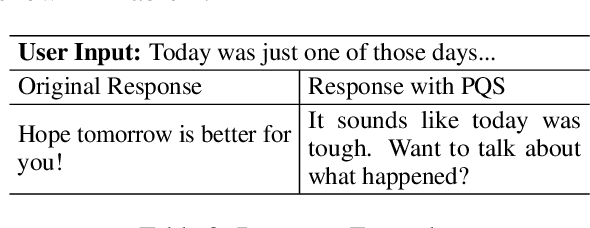
Abstract:Mental health issues significantly impact individuals' daily lives, yet many do not receive the help they need even with available online resources. This study aims to provide diverse, accessible, stigma-free, personalized, and real-time mental health support through cutting-edge AI technologies. It makes the following contributions: (1) Conducting an extensive survey of recent mental health support methods to identify prevalent functionalities and unmet needs. (2) Introducing SouLLMate, an adaptive LLM-driven system that integrates LLM technologies, Chain, Retrieval-Augmented Generation (RAG), prompt engineering, and domain knowledge. This system offers advanced features such as Risk Detection and Proactive Guidance Dialogue, and utilizes RAG for personalized profile uploads and Conversational Information Extraction. (3) Developing novel evaluation approaches for preliminary assessments and risk detection via professionally annotated interview data and real-life suicide tendency data. (4) Proposing the Key Indicator Summarization (KIS), Proactive Questioning Strategy (PQS), and Stacked Multi-Model Reasoning (SMMR) methods to enhance model performance and usability through context-sensitive response adjustments, semantic coherence evaluations, and enhanced accuracy of long-context reasoning in language models. This study contributes to advancing mental health support technologies, potentially improving the accessibility and effectiveness of mental health care globally.
Interpretable Spatio-Temporal Embedding for Brain Structural-Effective Network with Ordinary Differential Equation
May 21, 2024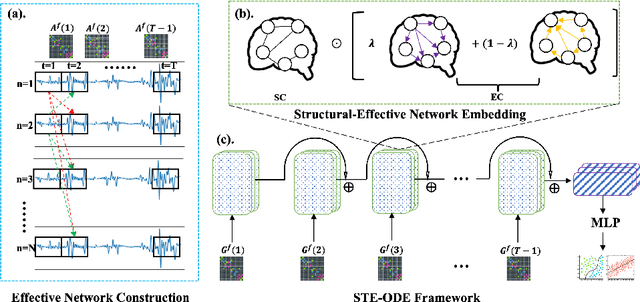
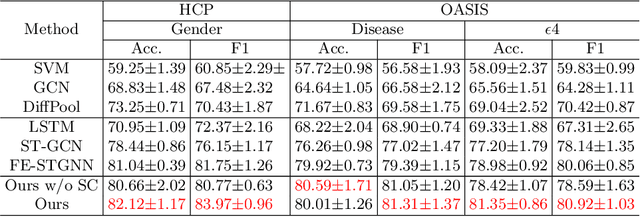
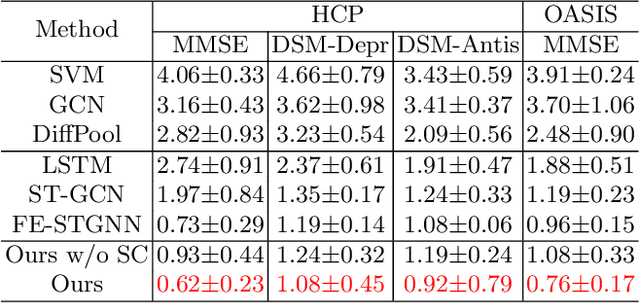
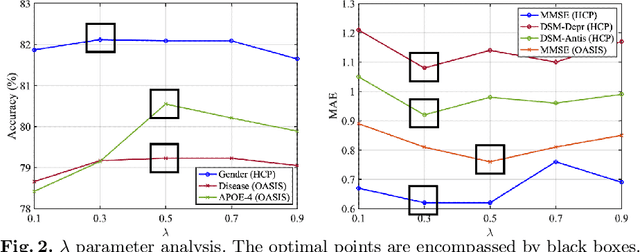
Abstract:The MRI-derived brain network serves as a pivotal instrument in elucidating both the structural and functional aspects of the brain, encompassing the ramifications of diseases and developmental processes. However, prevailing methodologies, often focusing on synchronous BOLD signals from functional MRI (fMRI), may not capture directional influences among brain regions and rarely tackle temporal functional dynamics. In this study, we first construct the brain-effective network via the dynamic causal model. Subsequently, we introduce an interpretable graph learning framework termed Spatio-Temporal Embedding ODE (STE-ODE). This framework incorporates specifically designed directed node embedding layers, aiming at capturing the dynamic interplay between structural and effective networks via an ordinary differential equation (ODE) model, which characterizes spatial-temporal brain dynamics. Our framework is validated on several clinical phenotype prediction tasks using two independent publicly available datasets (HCP and OASIS). The experimental results clearly demonstrate the advantages of our model compared to several state-of-the-art methods.
Constrained Multiview Representation for Self-supervised Contrastive Learning
Feb 05, 2024Abstract:Representation learning constitutes a pivotal cornerstone in contemporary deep learning paradigms, offering a conduit to elucidate distinctive features within the latent space and interpret the deep models. Nevertheless, the inherent complexity of anatomical patterns and the random nature of lesion distribution in medical image segmentation pose significant challenges to the disentanglement of representations and the understanding of salient features. Methods guided by the maximization of mutual information, particularly within the framework of contrastive learning, have demonstrated remarkable success and superiority in decoupling densely intertwined representations. However, the effectiveness of contrastive learning highly depends on the quality of the positive and negative sample pairs, i.e. the unselected average mutual information among multi-views would obstruct the learning strategy so the selection of the views is vital. In this work, we introduce a novel approach predicated on representation distance-based mutual information (MI) maximization for measuring the significance of different views, aiming at conducting more efficient contrastive learning and representation disentanglement. Additionally, we introduce an MI re-ranking strategy for representation selection, benefiting both the continuous MI estimating and representation significance distance measuring. Specifically, we harness multi-view representations extracted from the frequency domain, re-evaluating their significance based on mutual information across varying frequencies, thereby facilitating a multifaceted contrastive learning approach to bolster semantic comprehension. The statistical results under the five metrics demonstrate that our proposed framework proficiently constrains the MI maximization-driven representation selection and steers the multi-view contrastive learning process.
Contrastive Brain Network Learning via Hierarchical Signed Graph Pooling Model
Jul 14, 2022



Abstract:Recently brain networks have been widely adopted to study brain dynamics, brain development and brain diseases. Graph representation learning techniques on brain functional networks can facilitate the discovery of novel biomarkers for clinical phenotypes and neurodegenerative diseases. However, current graph learning techniques have several issues on brain network mining. Firstly, most current graph learning models are designed for unsigned graph, which hinders the analysis of many signed network data (e.g., brain functional networks). Meanwhile, the insufficiency of brain network data limits the model performance on clinical phenotypes predictions. Moreover, few of current graph learning model is interpretable, which may not be capable to provide biological insights for model outcomes. Here, we propose an interpretable hierarchical signed graph representation learning model to extract graph-level representations from brain functional networks, which can be used for different prediction tasks. In order to further improve the model performance, we also propose a new strategy to augment functional brain network data for contrastive learning. We evaluate this framework on different classification and regression tasks using the data from HCP and OASIS. Our results from extensive experiments demonstrate the superiority of the proposed model compared to several state-of-the-art techniques. Additionally, we use graph saliency maps, derived from these prediction tasks, to demonstrate detection and interpretation of phenotypic biomarkers.
Functional2Structural: Cross-Modality Brain Networks Representation Learning
May 06, 2022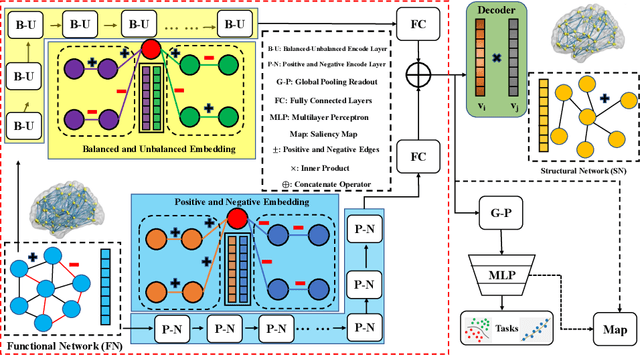
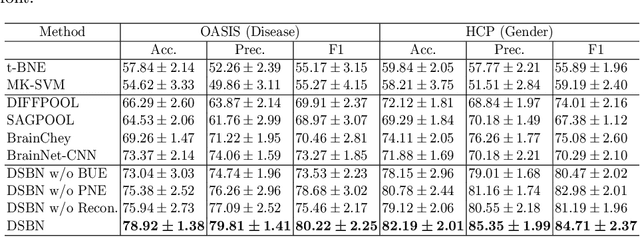

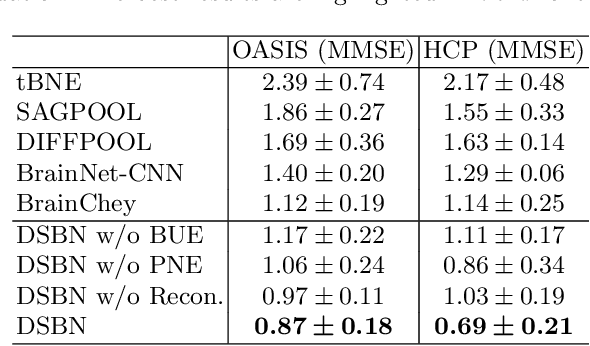
Abstract:MRI-based modeling of brain networks has been widely used to understand functional and structural interactions and connections among brain regions, and factors that affect them, such as brain development and disease. Graph mining on brain networks may facilitate the discovery of novel biomarkers for clinical phenotypes and neurodegenerative diseases. Since brain networks derived from functional and structural MRI describe the brain topology from different perspectives, exploring a representation that combines these cross-modality brain networks is non-trivial. Most current studies aim to extract a fused representation of the two types of brain network by projecting the structural network to the functional counterpart. Since the functional network is dynamic and the structural network is static, mapping a static object to a dynamic object is suboptimal. However, mapping in the opposite direction is not feasible due to the non-negativity requirement of current graph learning techniques. Here, we propose a novel graph learning framework, known as Deep Signed Brain Networks (DSBN), with a signed graph encoder that, from an opposite perspective, learns the cross-modality representations by projecting the functional network to the structural counterpart. We validate our framework on clinical phenotype and neurodegenerative disease prediction tasks using two independent, publicly available datasets (HCP and OASIS). The experimental results clearly demonstrate the advantages of our model compared to several state-of-the-art methods.
 Add to Chrome
Add to Chrome Add to Firefox
Add to Firefox Add to Edge
Add to Edge